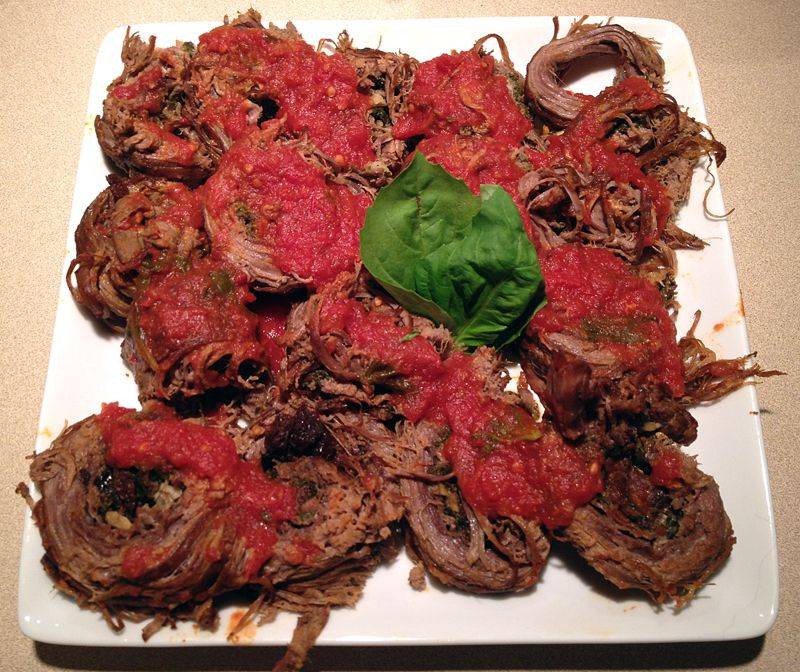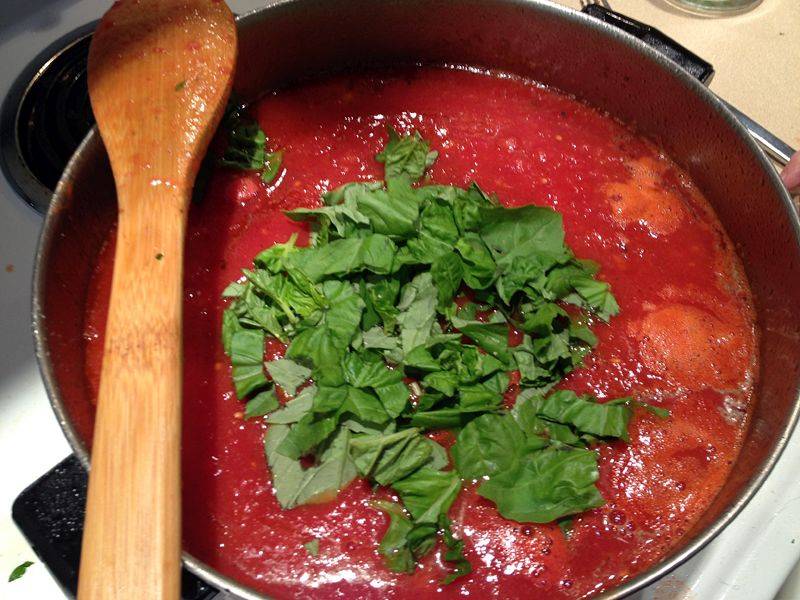A few months ago, I cooked some Israeli food with my friend and her mom. Last week, I cooked some Italian food with my grandmother. My grandparents were in town for a few days. They stayed with me and my husband, and even though I fully intended to finally prove my adulthood to them, I sat back and watched my grandmother commandeer my kitchen. To be fair, I did have a fairly lengthy list of things I wanted her to make. What can I say? I miss her cooking.
As a child I’d watch my great-grandmother and my grandmother in the kitchen. There were things that I learned without knowing that I learned them (at the time, at least). I can now appreciate that time spent observing, and take advantage of the time I now have with my grandmother to be an active participant in the cooking process (as much as she lets me). There are a few dishes that I love and just wanted her to make. There are also a few dishes that I now make, but am eager to have taste more like her cooking.
Cooking with another person is a true bonding experience. It’s sort of like going through a traumatic situation: you get to learn more about how the other person thinks and functions. Because you’re each performing physical tasks that contribute to an immediate goal (the meal), you occupy an intimate space and you’re forced to position your actions with and in relation to each other. If you’re into anything creative, you’ll understand how difficult it can be to open up your space and your processes to another person.
 I often talk about nostalgia and comfort food in my articles, and something I think about fairly regularly (in a healthy, un-depressed way). If I’m feeling homesick, or needing a dose of comfort, the only thing I make is Sunday supper: pasta with tomato sauce and meatballs. My sauce and meatballs are pretty good, if I do say so myself, but they are not my grandmother’s. While she was visiting, I was determined to watch and document her sauce and meatball making in an effort to align my own versions with hers. One thing I don’t usually make is beef braciole; I’m usually only cooking for two, and braciole is one of those things that I haven’t really incorporated as a go-to, even though I love it. There was nothing fancy or elaborate about our menu – it’s simple peasant food. We made tomato sauce, pasta, meatballs, braciole, and a green salad.
I often talk about nostalgia and comfort food in my articles, and something I think about fairly regularly (in a healthy, un-depressed way). If I’m feeling homesick, or needing a dose of comfort, the only thing I make is Sunday supper: pasta with tomato sauce and meatballs. My sauce and meatballs are pretty good, if I do say so myself, but they are not my grandmother’s. While she was visiting, I was determined to watch and document her sauce and meatball making in an effort to align my own versions with hers. One thing I don’t usually make is beef braciole; I’m usually only cooking for two, and braciole is one of those things that I haven’t really incorporated as a go-to, even though I love it. There was nothing fancy or elaborate about our menu – it’s simple peasant food. We made tomato sauce, pasta, meatballs, braciole, and a green salad.
Because we missed the Market on Saturday, we picked up some fresh produce from Common Ground Food Co-op, and a flank steak from Schnuck’s. We also stopped by Pekara and picked up a day-old baguette. Imported pastas and San Marzano tomatoes are available at World Harvest, but I already had those on hand in my pantry. My grandmother and I prefer Boar’s Head brand prosciutto, so we picked up about six slices for the braciole; Cheese and Crackers carries Boar’s Head and has a lovely cheese selection. I’m pretty sure that my grandmother didn’t believe me when I would tell her about the local food resources, so it was nice to take her around and show them off.
We kicked the men out of the kitchen, freeing us up to talk about life. It was a unique situation for me; I realize that it isn’t too often that I’ve had or have the undivided attention of my grandmother. When I’m visiting, there are usually other people around, or it’s a holiday and there is the cacophony of a large crowd of family members. This cooking adventure was in my kitchen, in the house my husband and I own, with my tools. In one way, it was about showing to her (and my grandfather) that I’ve grown up, become an adult, and now have a life of my own. In another way, it was a selfish way to spend as much time as possible with her in the kitchen in an attempt to learn everything I could about cooking, her life, and my family.
Unfortunately, we had neither the time nor the energy to make our own pasta. There is nothing quite like fresh pasta; dried pasta is fine, but it’s not melt-in-your-mouth delicious like fresh. So we used dried pasta. We used Barilla, but in light of chairman Guido Barilla’s recent comments, I recommend another brand. There’s a pretty good selection of imported pasta at World Harvest.
The first thing we did was make the meatballs. They can be made a day or two ahead  and kept in the fridge. You can also throw them in the freezer for future use. The key to good meatballs is keeping them moist. Many recipes will tell you to soak stale bread in milk; that’s fine, but we don’t do that. The way my grandmother was taught was with stale bread soaked in water. Why, you ask? Probably because her mother-in-law and teacher, my immigrant great-grandmother, was poor, and her people were poor, and so on, and so on.
and kept in the fridge. You can also throw them in the freezer for future use. The key to good meatballs is keeping them moist. Many recipes will tell you to soak stale bread in milk; that’s fine, but we don’t do that. The way my grandmother was taught was with stale bread soaked in water. Why, you ask? Probably because her mother-in-law and teacher, my immigrant great-grandmother, was poor, and her people were poor, and so on, and so on.
My maternal grandparents grew up as first and second generation Italian-Americans in Brooklyn. Most Italian immigrants coming into New York City between 1880 and 1910 were from Southern Italy. Southern Italy was not industrialized like Northern Italy, and famine, poverty, and lack of opportunity brought many Southern Italians to American shores in search of a better life. My maternal kin all originally hail from Southern Italy: Naples, Salerno, Bari, Sicily. Although these are all independent places within Southern Italy and different from each other, the cuisines and cultures are similar, and after a generation or two in the United States, the differences between Sicilian tomato sauce and Neapolitan tomato sauce became more homogenized, or no longer important.
The food my family tends to cook is food that’s historically been peasant food. A little meat, a little milk, nothing too fancy. Of course, these things have been adapted and reconfigured in the last century, but the essence of the food is simple. The cooking tradition was initially based upon an agricultural lifestyle, and as it was adapted for American living, married off, adjusted, and repackaged, the broad strokes remained constant while the finer details were tweaked.
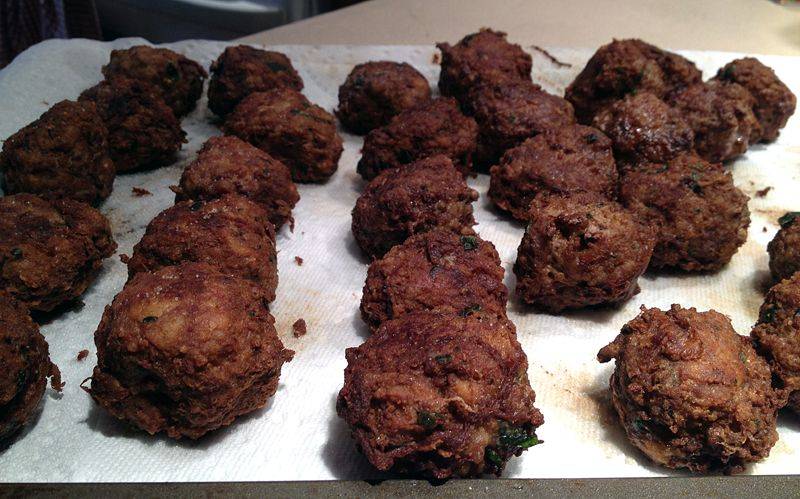 Back to the meatballs. We took about half of the stale loaf and soaked it in a large bowl of water while we compiled the other ingredients. We used a mixture of ground beef, ground pork, and ground veal, using about a pound and a quarter of beef, and a little more than a half pound each of pork and veal. We then added in the now-soaked insides of the bread – we left the crust out. Eggs, salt, pepper, finely grated parmesan cheese, and finely chopped parsley rounded out the remaining ingredients. Into the frying pan went the little balls, and out they came about half-way cooked. They finished cooking in the tomato sauce.
Back to the meatballs. We took about half of the stale loaf and soaked it in a large bowl of water while we compiled the other ingredients. We used a mixture of ground beef, ground pork, and ground veal, using about a pound and a quarter of beef, and a little more than a half pound each of pork and veal. We then added in the now-soaked insides of the bread – we left the crust out. Eggs, salt, pepper, finely grated parmesan cheese, and finely chopped parsley rounded out the remaining ingredients. Into the frying pan went the little balls, and out they came about half-way cooked. They finished cooking in the tomato sauce.
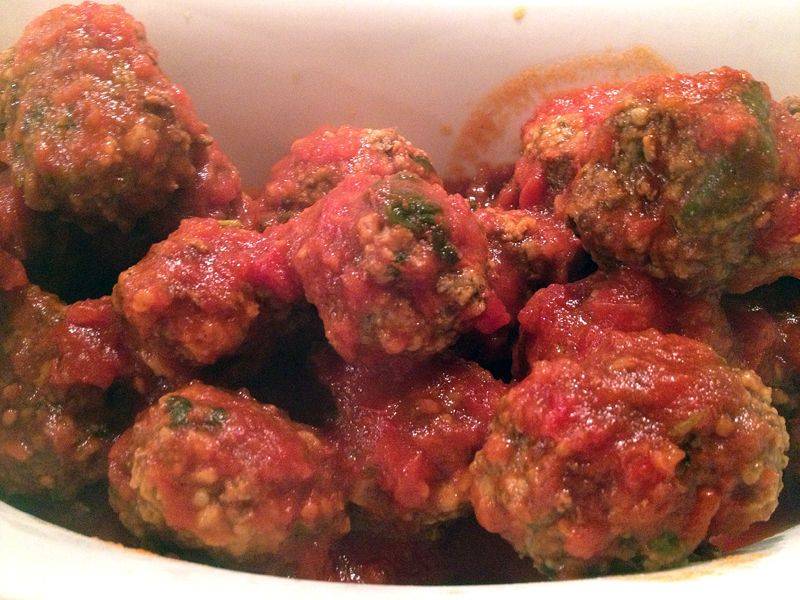
Our next task was the braciole. You can use either beef or pork; I prefer beef, so we purchased a flank steak. If it’s super thick, you’ll have to butterfly it. It’s worth asking the butcher if s/he’ll do it. If not, get a sharp knife and carefully slice it in half as to open it up like a book. Once you’ve butterflied the meat, grab a meat tenderizer, rolling pin, or empty wine bottle and pound it out. You want to break up some of the tissue and jump-start the tenderizing process. Don’t make it too thin, though – just make it flat and even. Place your meat to the side. (Yes, you can leave it out on the counter.)
Next, you’ll need to slice or chop four to eight cloves of garlic, depending on size 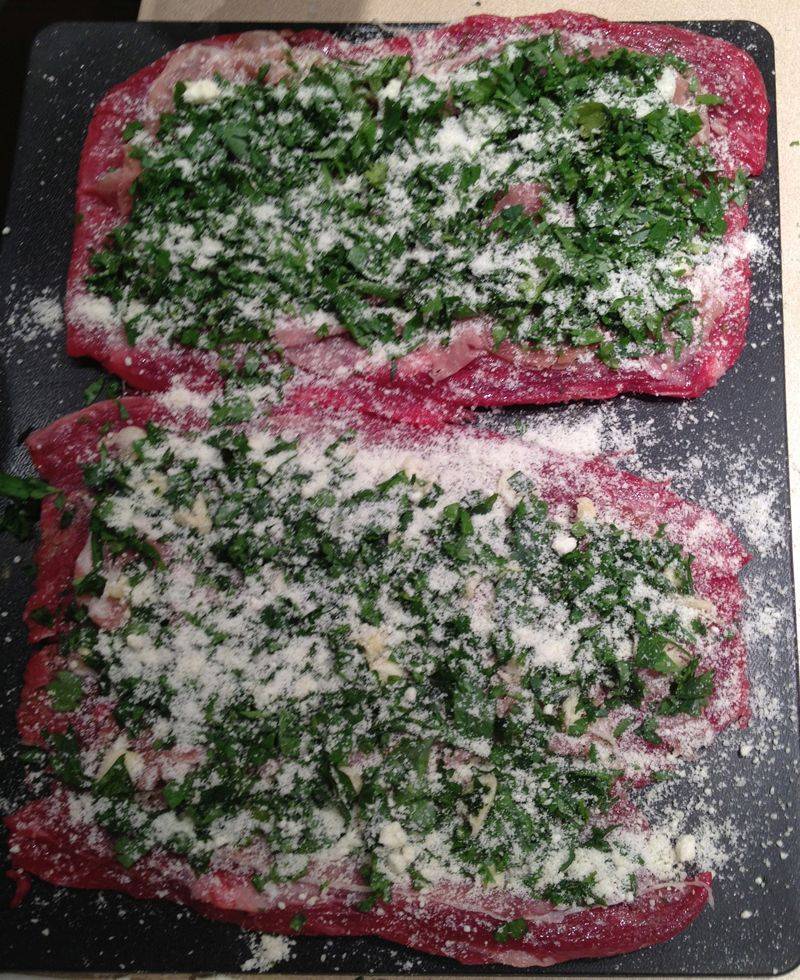 and taste preferences. After you chop the garlic, finely chop Italian flat leaf parsley, you’ll need about a cup or so. If you’re making meatballs, too, you’re going to need a good, hefty bunch. Once all of those things have been cut and prepped, you can begin to assemble.
and taste preferences. After you chop the garlic, finely chop Italian flat leaf parsley, you’ll need about a cup or so. If you’re making meatballs, too, you’re going to need a good, hefty bunch. Once all of those things have been cut and prepped, you can begin to assemble.
First, salt and pepper the insides of your flank steak. Then lay the prosciutto down on the seasoned steak. If it suits you, you could also use Genoa salami – thinly sliced – and/or provolone cheese. Next, sprinkle the garlic all over, and place the parsley on top. Be generous with both, as they provide a lot of flavor. You can then generously dust the steak with finely grated parmesan cheese. If you like raisins, I highly recommend adding them. They add a nice hint of sweetness. Once you’ve assembled your meat, you’ll need to roll and tie it up. Kitchen twine is going to be your best friend; toothpicks are just going to give you a headache. Roll, wrap, and tie that thing up good. If you have two pieces (if you sliced them in half, that is), then you’ll have two little bundles of joy.
 In a heavy bottomed pot, heat up some olive oil and a few garlic cloves over medium high heat. The garlic should start to brown – don’t let it burn or it will be bitter. You want to use it to infuse flavor into the oil. As it’s heating up, season the outside of the meat with salt and pepper. Once the oil is hot, carefully drop in your braciole. You want to brown all sides of the tasty bundles. Feel free to pull the garlic cloves out of the pan at this point.
In a heavy bottomed pot, heat up some olive oil and a few garlic cloves over medium high heat. The garlic should start to brown – don’t let it burn or it will be bitter. You want to use it to infuse flavor into the oil. As it’s heating up, season the outside of the meat with salt and pepper. Once the oil is hot, carefully drop in your braciole. You want to brown all sides of the tasty bundles. Feel free to pull the garlic cloves out of the pan at this point.
As they brown, prep your sauce. If you’re making it from scratch, open up your cans of tomatoes and get the salt handy. If you’re adding premade sauce, well, I’m not entirely sure what to do, but I imagine that you should just open the jars and get ready to pour. As the meat comes close to being browned on all sides, you can add a dash or generous pour of red wine. If you don’t have any, no worries.
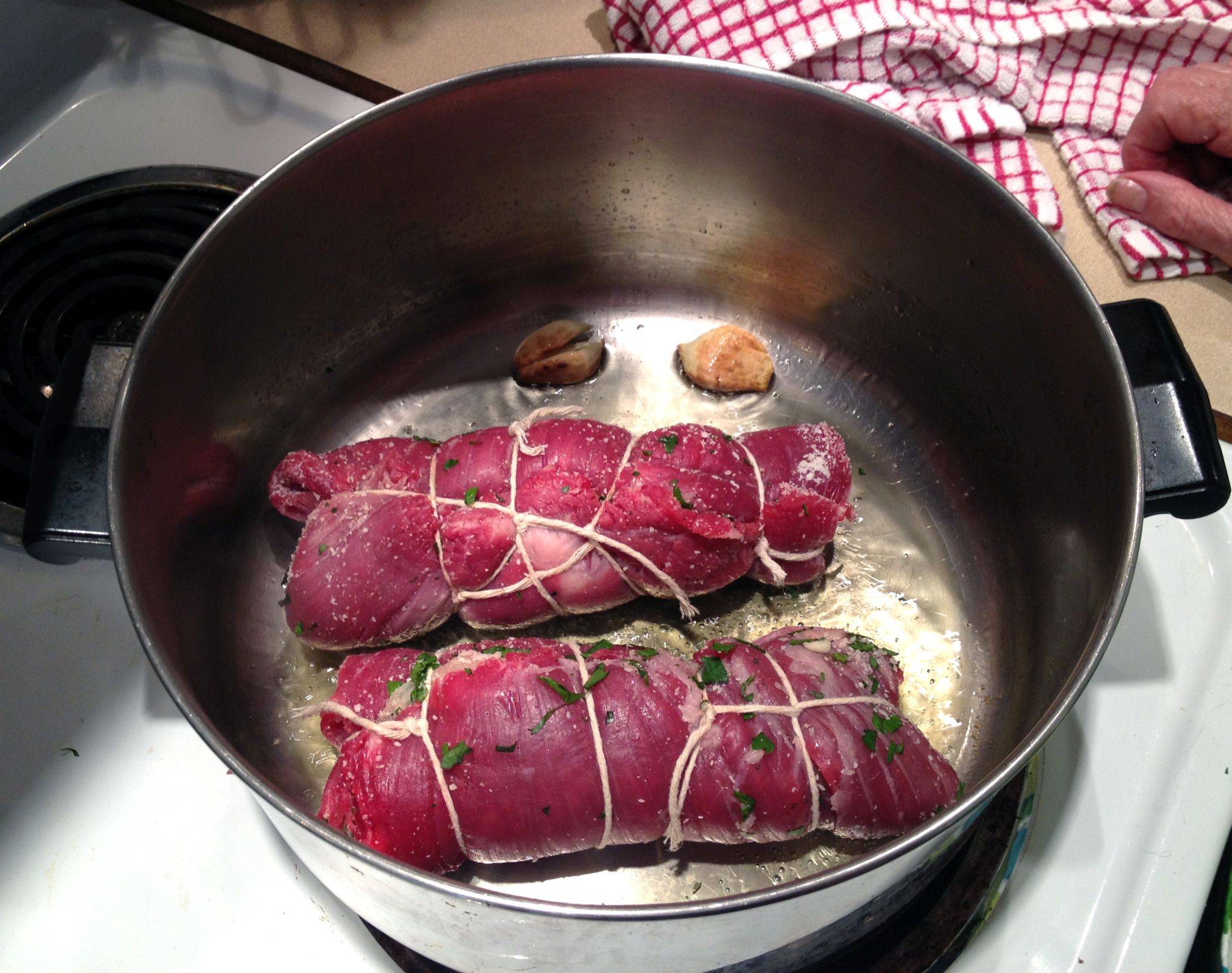
Once the meat is browned on all sides, add your tomatoes or jarred sauce. Don’t be stingy with the sauce. Drop the heat to low, and let it simmer for a few hours, checking and stirring every so often. Vent a lid on the pot. When you’re ready to eat, take the braciole out of the sauce. Remove the twine and slice. Serve with the meatballs and pasta, and be sure to put some extra sauce on top. Buon appetito!
The entire visit and process, from collecting my grandparents from the airport and bringing them back to C-U, to shopping for Italian ingredients, was an affirmation that I have indeed made Champaign-Urbana my home. Authenticity isn’t necessarily determined by the label of origin, but rather by the experiences that inform one’s actions.
Share your food story with Jess, or invite her to dinner!
